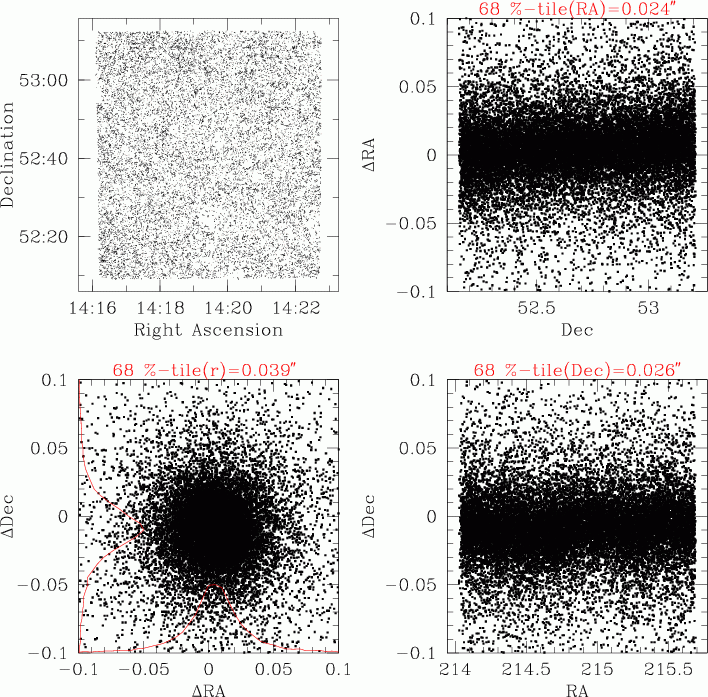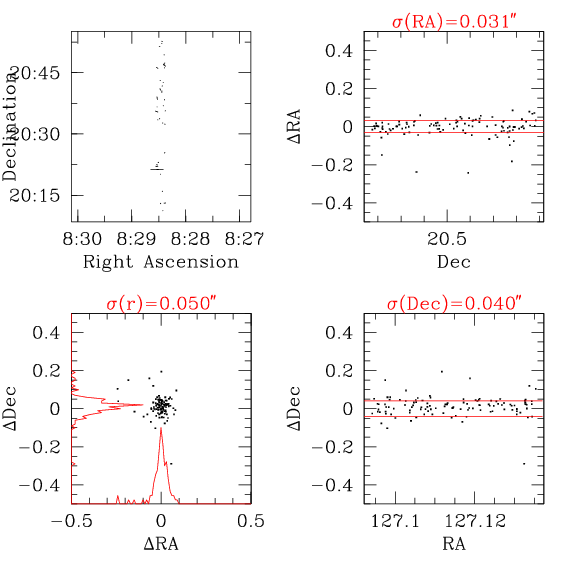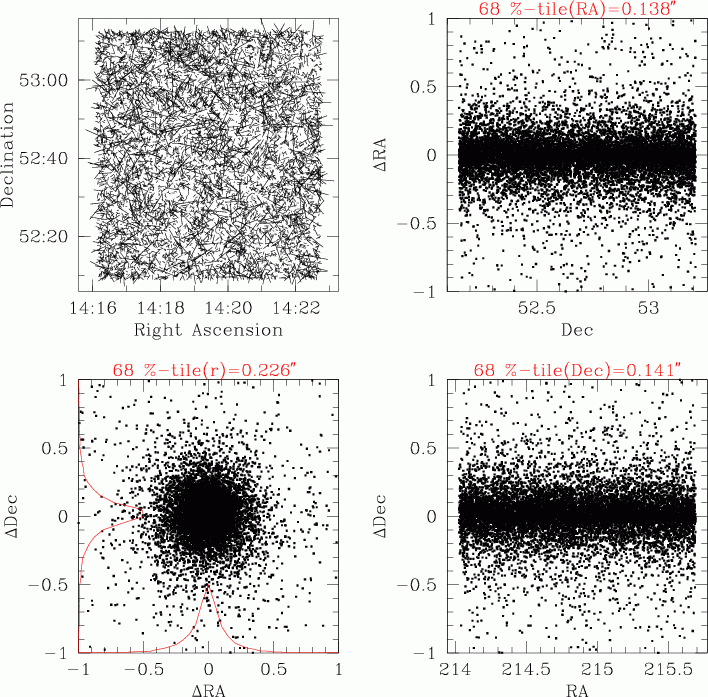Checks on Astrometry
The internal astrometric accuracy (between the stacked images of a group) is typically 0.04 arcseconds radially or 0.025 in any one direction. The repeatability (the residuals between two completely independent astrometric determinations), is about 0.06 arcseconds. The external astrometric accuracy (between the stacks and the external reference frame) is typically 0.20 arcseconds radially or 0.14 in any one direction.
Internal accuracy
The internal accuracy is checked by running SExtractor on each stacked image in every band of each group and obtaining catalogues of object positions. The positional catalogues for each band are matched to each other and common objects identified. If the astrometry is perfect, then the position of an object in each band will be identical. In practice, there are astrometric residuals. Examining these residuals gives an idea of the astrometric uncertainties.
The figure below shows checks on the internal astrometry between two typical images in a group. The top left quarter shows the direction and size (greatly enlarged) of the astrometric residuals as line segments. This plot is an important diagnostic of astrometry because, while the residuals are typically quite small, there are outliers in any distribution. As long as these outliers are relatively isolated from each other and pointing in random directions all is well. Conversely, if there are a number of large residuals in close proximity to each other, all pointing the same direction, this indicates a systematic misalignment between the two images in question. The figure shows no such misalignments. The bottom left quarter shows the astrometric residuals in RA and Dec. The red histograms show the relative distribution of the residuals in both directions. The 68th percentile of the residuals is 0.060 arcseconds radially. The two right panels show the residuals in RA and Dec separately.

Over all, the astrometric residuals are about 0.04 arcseconds (68th percentile) in a radial sense or about 0.025 in any one direction. Note that there should be a factor of √2 between these two uncertainties.
Repeatability
The test described above was applied to every pair of images within each of the groups with similar results. This of course might not be too surprising, since the images were registered to each other in the first place. For example, if there is g and i data in a group, the i image is made first and then the g data is astrometrically mapped to the i image as described in astrometric calibration documentation. Therefore, even if there are systematic errors in the i astrometry, the g data is mapped to the erroneous positions, and the residuals between the g and i image will still be small.
However, this test is also applied between images belonging to different groups. Since the astrometric calibration of one group is completely independent of that of another group, comparing the residuals between different groups is a more stringent test of the repeatability of the astrometry. The figure below shows the astrometric residuals between two groups. The different panels have the same significance as in the previous figure. Groups tend to overlap only at the edges, in a thin strip, as shown in the top left panel. Consequently, the number of common sources between two groups will be much smaller than between two stacks in the same group. The residuals in this case are 0.05 arcseconds. More typically, averaging over all the group overlaps, the repeatability is 0.06 arcseconds.

External accuracy
This is checked by matching the catalogue for each field back to the astrometric reference catalogue. Again, the scatter in the astrometric residuals is a measure of the uncertainty, and the presence of any localized large residuals indicates a systematic shift.
The figure below shows checks on the external astrometry. The panels have the same significance as above. The only difference is that the residuals are larger. Note that there are uncertainties in the external astrometric catalogue as well. In this case, the SDSS is used as a reference. The astrometric uncertainties inherent in the SDSS are 0.05 to 0.10 arcseconds (Pier, et al. 2003).

- Date modified: